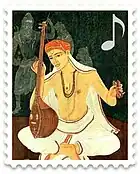 | ||||||
| Music of India | ||||||
| Genres | ||||||
|---|---|---|---|---|---|---|
|
Traditional
Modern |
||||||
| Media and performance | ||||||
|
||||||
| Nationalistic and patriotic songs | ||||||
|
||||||
| Regional music | ||||||
|
||||||
Mizoram is a region in India. Its folk music consists of vocals (singing) accompanied by traditional drums, gong and other native percussion instruments. There is also a long history of flute-playing which is now defunct. The drums are made from a hollow tree trunk with membrane made from cow hide and the gongs, made of brass, are very similar to those found in Myanmar.
History
It is difficult to trace the origin and to arrange the chronological sequences of the heritage of Mizo Music. However, some couplets were developed during the settlement of Thantlang in Burma, estimated between 1300-1400 AD. As recorded by B. Lalthangliana, the folk songs developed during this period were dar hla (songs on gong); Bawh hla (War chants), Hlado (Chants of hunting); Nauawih hla (Cradle songs) A greater development of songs can be seen from the settlement of Lentlang in Burma, estimated between late 15th to 17th Century AD.[1]
In precolonial times, the Mizos used the drum, gong and mouth organ made of gourd and bamboo as musical instruments. With adoption of Christianity, musical instruments other than the drum lost their appeal. The first Musical instrument to enter Mizoram was the mouth organ brought in by Mrs Fraser in 1907. Mr Vankhama, a well known composer was influential in popularizing the guitar in Mizoram.[2]
Classification
The Mizos have a traditional way of classifying their folk songs. A study of their folksongs on the basis of their own system of classification shows that the Mizos have about one hundred different types of folksongs.[3]
Musical Instruments
From time immemorial, the Mizo have been using different musical instruments. Even though we cannot date the origin, the "Mizo of Kabaw Valley during late 10th to 13th century AD had developed their music as nearly as they have done today".[4]
Khuang
Khuang (drum) is a Mizo indigenous instrument which occupies a very significant place in Mizo social and religious life. Khuang is a must on all occasions. It is made of hollow tree, wrapped on both sides with animal skin. The Mizo gives different names according to its size and length. The big sized one is called Khuangpui (Big drum), the middle one is called Khuanglai; and the small sized, Khuangte (little drum). If it is longish, they called it Kawlkhuang. As far as the history of Mizo is concerned it is commonly concluded that the Mizo ancestors started using drum as far back as when they sang and composed song. Lianhmingthanga believes that the Mizo had received drum from Chinese civilisation through cultural diffusion. The process of that cultural diffusion might have passed through the Burmese with whom the Mizo had a close cultural contact which took place from the middle of the 9th century AD until the end of Pagan period at the close of the 13th century AD.[5]
Darmang
Darmang is the smallest type of gong. It has no effect without other gongs or instruments, but it is used in the traditional dances to keep timing. All these gongs appear to be Burmese in origin, and therefore, it is tempting to conclude that Mizo got them from the Burmese while they were living in the Kabaw Valley during 9th to 13th century AD.[6]
Wind Instruments
The Mizo have six varieties of wind instruments such as Rawchhem, Tumphit, Mautawtawrawl, Phenglawng, Buhchangkuang, Hnahtum.[7]
Artists
The earliest popular Mizo artists include Lallianmawia Pachuau, CFL Hmingthanga, Lalṭanpuia Tochhawng, C. Lalrinmawia, K. Lalchamliana, H. Lalṭhakima, and Liandailova Chhangte. Popular female artists include Daduhi, Liandingpuii, Catherine Khiangte, Zoramchhani, Spi and Mami Varte in the current generation, and Vanhlupuii, Vanlalruati and C. Luri as more senior artists. Popular male artists include Booma, Vanlalsailova, Michael M Sailo, Joseph Zaihmingthanga, and F. Zothlamuana (Atea) Cellevain Mama Chawngthu. [8]
Notes
- ↑ B. Thangliana, Mizo Literature, 1993, p.76
- ↑ Pachuau, Joy. The Camera as Witness. Cambridge. p. 37. ISBN 9781107073395.
- ↑ Lalruanga, A study on Mizo Folk Literature, unpublished tunes.
- ↑ B.Lalthangliana, History of Mizo in Burma, p.71
- ↑ Lianhmingthanga, Material culture of the Mizo, 1998, p.30
- ↑ B. Lalthangliana, History of Mizo in Burma, p.10
- ↑ K. Zawla, Mizo Pipute leh an Thlahte Chanchin, p.82
- ↑ Kathryn McKenzie, Chhinlung Magazine, Vol. II, 1986, p.19.
References
- Thangliana, B., Mizo Literature.
- Lalruanga, A study on Mizo Folk Literature.
- Zawla, K., Mizo Pipute leh an Thlahte Chanchin.
- Lalthangliana, B., History of Mizo in Burma.
- Lianhmingthanga, Material culture of the Mizo, 1998.
- Thanmawia, B., Mizo and Music, Mizoram News Magazine, Autumn Issue, 1985, p. 12
- McKenzie, Kathryn, Chhinlung Magazine.